Alfalfa is a perennial flowering plant in the pea family Fabaceae. Alfalfa is used for livestock feed as well as soil-building green manure. Alfalfa is used in North America, South America, Australia, and New Zealand. The plant was first cultivated in Iran and spread to Europe and the Mediterranean.
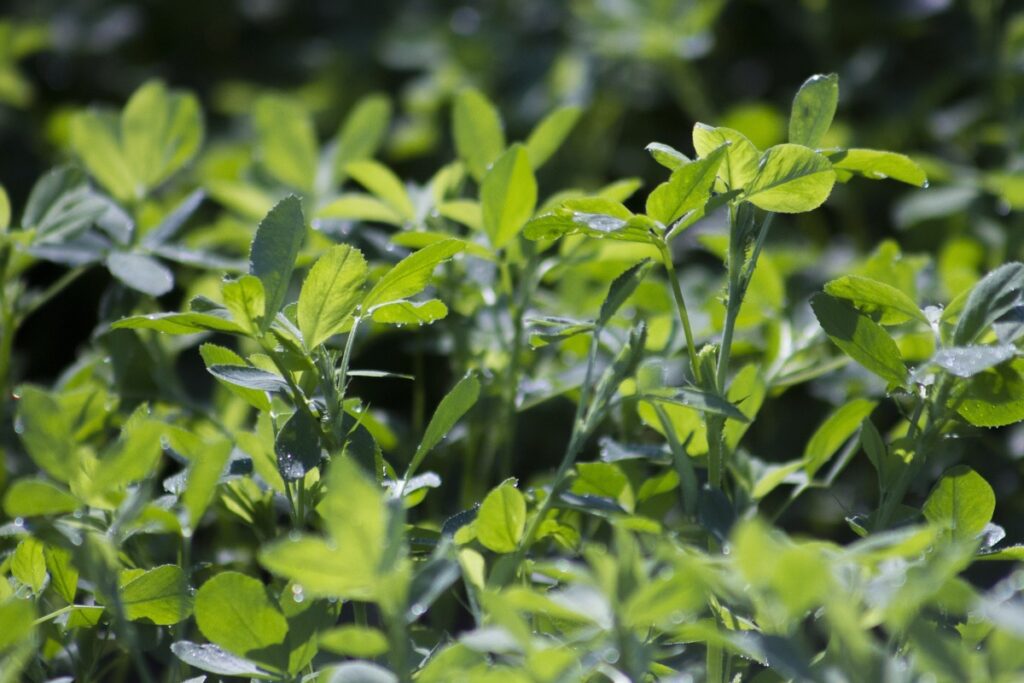
Alfalfa is a highly nutritious forage crop harvested for hay or fed fresh to livestock. It is high in protein and vitamins A and D. Alfalfa is also an excellent calcium, magnesium, and potassium source. This guide teaches about growing alfalfa from seed indoors, outdoors, and in pots.
How to grow Alfalfa from seed
Growing conditions for Alfalfa
Alfalfa is a perennial legume grown in various climates and soils. However, it prefers well-drained, sandy loam soils with pH 6.0 to 7.5. Alfalfa also needs full sun and at least six hours of direct sunlight daily to thrive. While alfalfa can tolerate drought conditions, it does best when irrigation is available. Three to four cuttings per season are usually taken when growing alfalfa for hay or silage. For grazing, two to three cuttings are often made per season.
Alfalfa propagation
Alfalfa is a highly nutritious forage crop that is grown around the world. It is a legume, which means it has nitrogen-fixing bacteria in its roots that help to improve soil fertility. Alfalfa is often used as animal feed, but you can also use it as a cover crop or green manure. Alfalfa propagation is relatively easy and can be done by seed or vegetative methods such as cuttings or transplants. Seed propagation is the most common method, and alfalfa seeds are typically sown in the spring.
You should sow seeds at a depth of 1/2 to 1 inch (1.3 to 2.5 cm), and they will germinate in 7 to 21 days. Cuttings can be taken from established plants in the spring or summer to propagate alfalfa by vegetative methods. You should take cuttings 4 to 6 inches (10 to 15 cm) long and from healthy, non-flowering stems. Transplants can also be made by uprooting young plants from an existing stand and replanting them elsewhere.
In case you missed it: Cabbage Farming Business Plan: How to Grow from Seed to Harvest
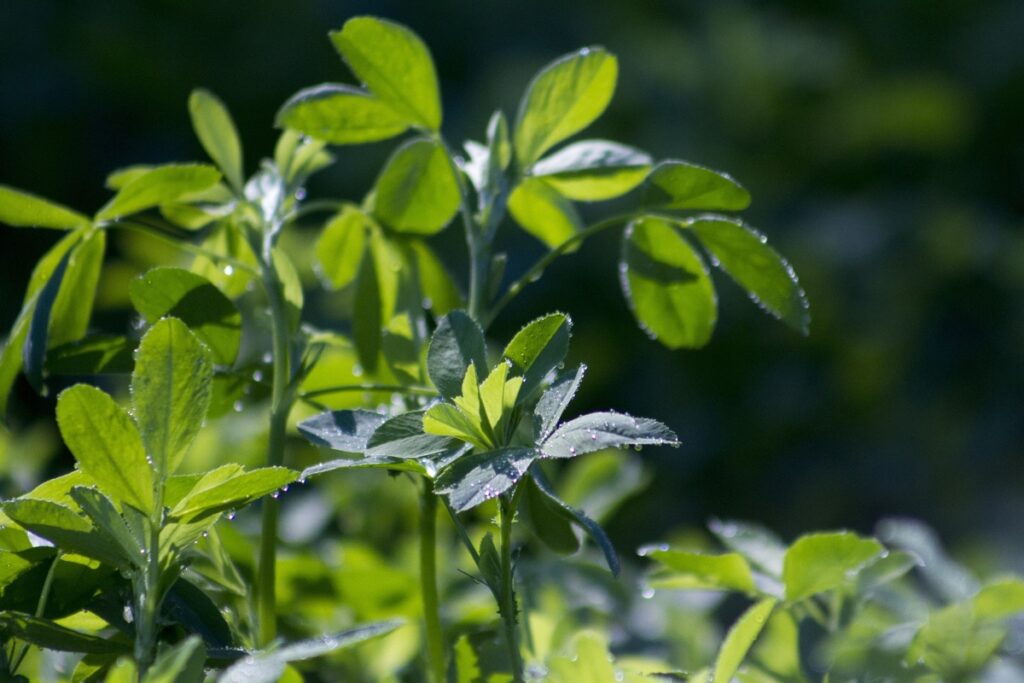
How long does Alfalfa take to grow
Alfalfa is a perennial forage crop that can be grown in most climatic regions. Alfalfa is a highly nutritious crop that is popular as both livestock feed and human food. The main appeal of alfalfa as livestock feed is its high protein content, which is essential for the growth and maintenance of muscle tissue. Alfalfa is also a good source of vitamins and minerals, including calcium, potassium, and vitamin A.
Alfalfa is relatively easy to grow and can be harvested year-round in most climates. The variety grown is the main factor determining how long it takes for alfalfa to reach maturity. Some alfalfa varieties take up to two years to reach full maturity, others can be ready to harvest in as little as six months, and some take as little as six weeks to grow from seed to full maturity. However, alfalfa generally takes about one year to reach full maturity.
How to plant and grow Alfalfa outdoors /planting Alfalfa seed on top of the ground
Assuming you have prepared the area you want to plant your alfalfa in by clearing it of debris and tilling the soil, you are ready to plant. Alfalfa is best planted using seedlings or plugs from a nursery instead of seeds. This is because alfalfa has a very long germination period and will not likely sprout if planted outdoors. To plant, dig holes in the ground that are big enough to accommodate the roots of your seedlings or plugs.
Gently place the plants in the holes and then cover them back up with soil, ensuring to firm it around the base of the plant. Water well immediately after planting. Once your alfalfa is established, it will need little care other than regular watering and mowing (to a height of 3-4 inches). It is important to fertilize your alfalfa regularly, as this will help it stay healthy and productive. You can apply compost, or manure tea applied every few weeks.
In case you missed it: Carrot Farming Business Plan: How to Grow from Seed to Harvest
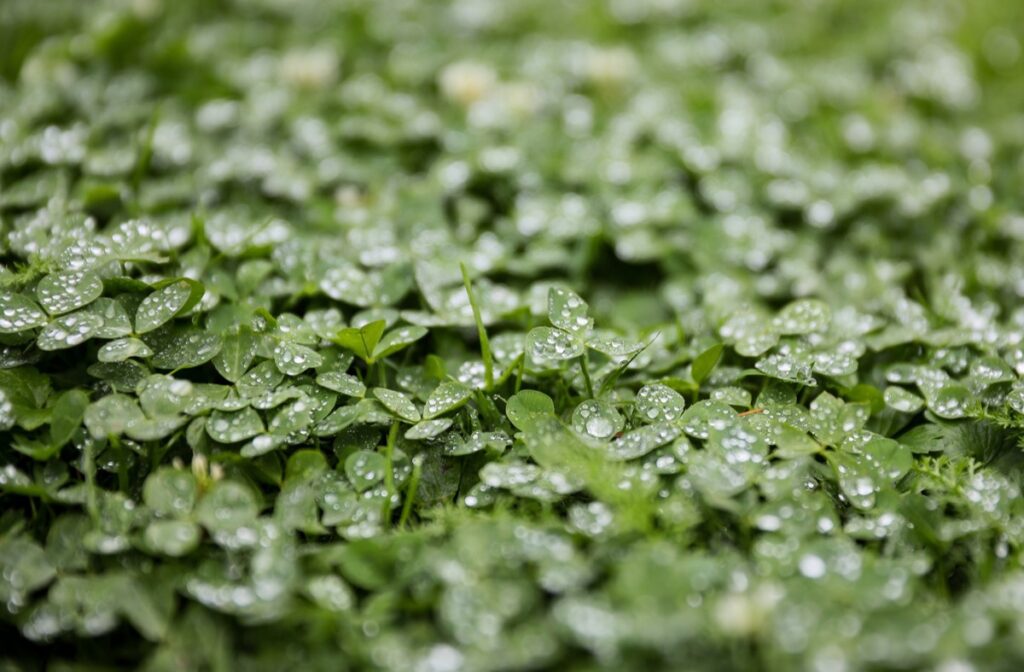
Will Alfalfa come back year after year?
Alfalfa is a perennial plant that will come back year after year. However, it is important to properly care for your alfalfa plants to ensure they remain healthy and productive. Proper care includes mowing the plants regularly, watering them deeply and regularly, and fertilizing them according to their needs. If you provide your alfalfa plants with the proper care, they will continue producing high-quality forage for years.
Growing Alfalfa Indoors
To grow alfalfa indoors, you must purchase alfalfa seeds and a soil-less growing mix. You will also need a container with good drainage and at least 6 inches deep. Fill your container with the growing mix and then wet it until it is evenly moist. Next, sow your alfalfa seeds on the surface of the growing mix and then cover them with a thin layer of the mix.
Place your container in a sunny location that receives indirect sunlight, and keep the mix moist but not soggy. Once your alfalfa sprouts appear, thin them out so that only the strongest seedlings remain. Allow your alfalfa to grow until it is about 6 inches tall and then cut it back to 3 inches tall. You can harvest your alfalfa by cutting it at the base of the plant.
Growing Alfalfa in pots
To grow alfalfa in pots, you’ll need a few supplies. First, you’ll need a pot at least 12 inches deep with drainage holes. You’ll also need potting soil, alfalfa seeds, and a watering can. To plant your alfalfa, fill your pot with potting soil and water it well. Then, sow your seeds on the surface of the soil and lightly cover them with more soil.
Your alfalfa seeds will germinate in 5-10 days. Once they’ve sprouted, thin the seedlings so that only the strongest ones are left. Continue to water your alfalfa regularly and fertilize it monthly with a liquid fertilizer. Harvest your alfalfa when it’s about 8 inches tall by cutting the leaves about 2 inches above the soil line.
Common mistakes in Growing Alfalfa
There are a few common mistakes that farmers make when growing alfalfa. One mistake is not properly preparing the seedbed. The seedbed should be free of debris. The second mistake is not planting the seeds at the proper depth. You should plant seeds at a depth of 1 to 1.5 inches. The third mistake is not applying enough fertilizer. Alfalfa requires a lot of nitrogen for proper growth.
The fourth mistake is not irrigation. Alfalfa needs to be irrigated regularly during the growing season. The fifth mistake is mowing the alfalfa too short. Mowing the alfalfa too short can reduce its yield and quality. The last mistake is not properly monitoring the pH of the soil. The ideal pH for alfalfa is between 6.5 and 7.0.
In case you missed it: How to Grow Medicinal Plants at Home: in Pots, Terraces, and Backyard

The best time of year to plant Alfalfa
The best time of year to plant alfalfa is typically in the spring after the last frost has passed. This allows the alfalfa plants to get a good start before the hot summer weather sets in. However, you can plant alfalfa in late summer or early fall and still get a good crop.
How many years will the Alfalfa field last?
Alfalfa is a perennial crop that can last several years with proper management. Good management practices allow an alfalfa field to last up to 10 years. Alfalfa is a deep-rooted crop with good drought tolerance and can withstand heavy grazing. It also improves soil health by fixing nitrogen.
Will Alfalfa reseed itself?
Alfalfa is a perennial plant, meaning it will live for more than two years and produce seeds yearly. The plant produces flowers pollinated by bees, which turn into seed pods. Each pod contains several seeds. Once the seeds mature, they are released from the pods and fall to the ground. If the conditions are right, the seeds will germinate and grow into new plants. Alfalfa will reseed itself if the conditions are right.
The plant needs full sun and well-drained soil to thrive. The ideal time to sow alfalfa seeds is in the spring or fall. If you live in cold winter, it’s best to sow the seeds in the fall so they have a chance to germinate before the ground freezes. If you want to ensure that your alfalfa patch continues to produce plants, it’s a good idea to sow new seeds yearly. This way, even if some of the seeds don’t germinate, you’ll still have a good crop of plants.
How many times do you cut Alfalfa a year?
One of the most common questions at our alfalfa farm is, “how many times do you cut alfalfa a year?” The answer to that question depends on a few factors, such as the climate, the rainfall, and the irrigation schedule. We will cut our alfalfa three to four times in a typical year. The first cutting usually happens in early May, when the weather starts warming up. We will cut again in late June or early July and September or October. Sometimes we will get a fourth cutting in November if the weather is still cooperative.
Of course, these are just general guidelines – every year is different, and we have to adjust our cutting schedule based on the conditions. If it’s a particularly wet spring, we may need to wait a little longer to cut so that the ground isn’t too muddy. Or if we’re in a drought, we may need to cut more frequently to help keep the plants from stress. But overall, three to four cuts per year is about average for most alfalfa farms. So if you’re wondering how often you should be cutting your alfalfa patch, that’s a good place to start.
In case you missed it: How to Grow Tomatoes in Australia from Seed: Best Time to Plant in Pots, the Backyard at Home for Sydney, Melbourne, and Victoria
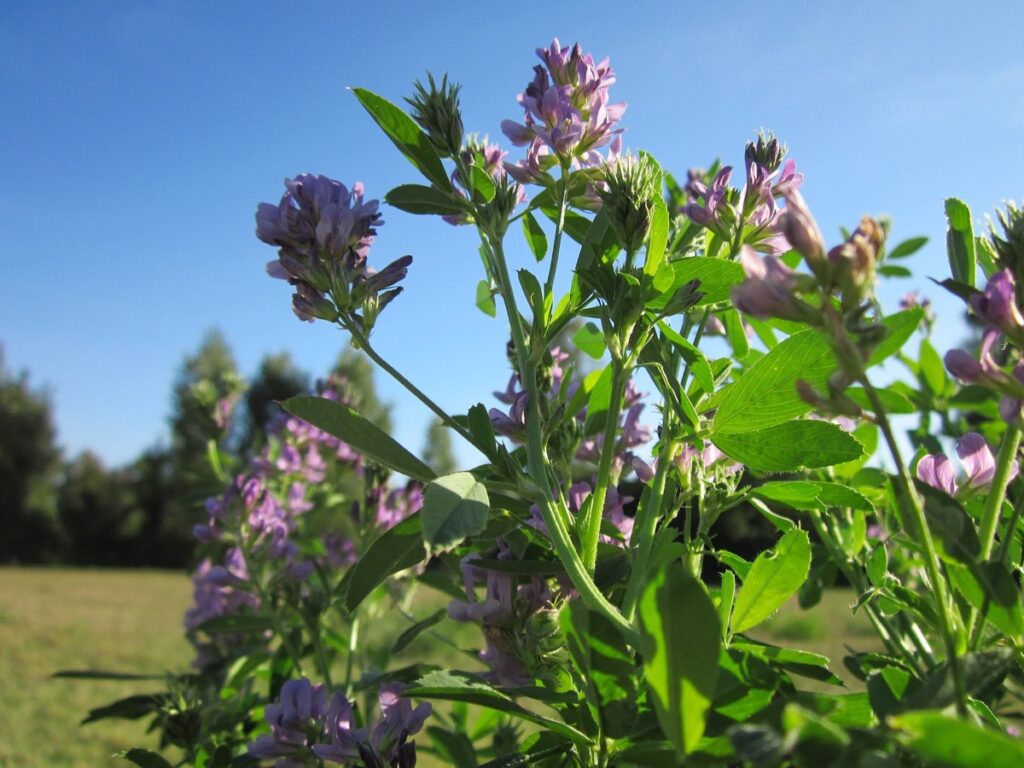
What happens if you cut Alfalfa before blooming?
If you cut alfalfa before it blooms, the plant will no longer be able to produce flowers or seeds. This can harm the quality of the hay that is produced from the alfalfa plants. In some cases, cutting the alfalfa before it blooms can also reduce crop yield.
What animal eats Alfalfa?
Alfalfa is a popular forage crop among farmers and ranchers. It is also known as “lucerne” in some parts of the world. This nutritious legume is beloved by many animals, including cows, horses, goats, sheep, and rabbits. Some birds, like chickens, also love this crop. Its nutrient-rich leaves are often used as animal feed, either fresh or dried.
Alfalfa hay is especially popular among horse owners, providing a healthy diet for their equine companions. So, what animal eats alfalfa? Pretty much any herbivore! If you have a farm or ranch with grazing animals, chances are they enjoy snacking on this tasty legume.
What do farmers spray on Alfalfa?
There are a variety of things that farmers spray on alfalfa, depending on the desired outcome. For example, farmers may spray herbicides to kill weeds or pesticides to kill insects. Farmers may also spray fertilizers to encourage growth.
When to cut the Alfalfa?
Alfalfa is a temperate climate forage crop grown in many parts of the world. It is a perennial plant, meaning it lives for more than two years, and has deep roots that help it to survive harsh winters and hot summers. Alfalfa is often used as animal feed because it is very nutritious.
The best time to cut alfalfa is when the plants are young and growing rapidly. This usually occurs in the spring but can vary depending on your location. If you cut the plants too early, they will not have enough leaves to regrow properly. If you wait too long to cut them, the plants will start to flower and go to seed, which reduces their nutritional value.
Best Fertilizers for Alfalfa
Alfalfa is a high-yielding forage crop grown in many parts of the world. The main nutrients required by alfalfa are nitrogen (N), phosphorus (P), and potassium (K). Nitrogen is needed for vegetative growth, while phosphorus is essential for root development. Potassium helps to promote disease resistance and increases the plant’s tolerance to stress. To get the best yields from your alfalfa crop, it is important to use the best available fertilizers.
In case you missed it: How to Grow Cassava/Yuca from Cuttings and Tubers: A Guide for Planting to Harvesting
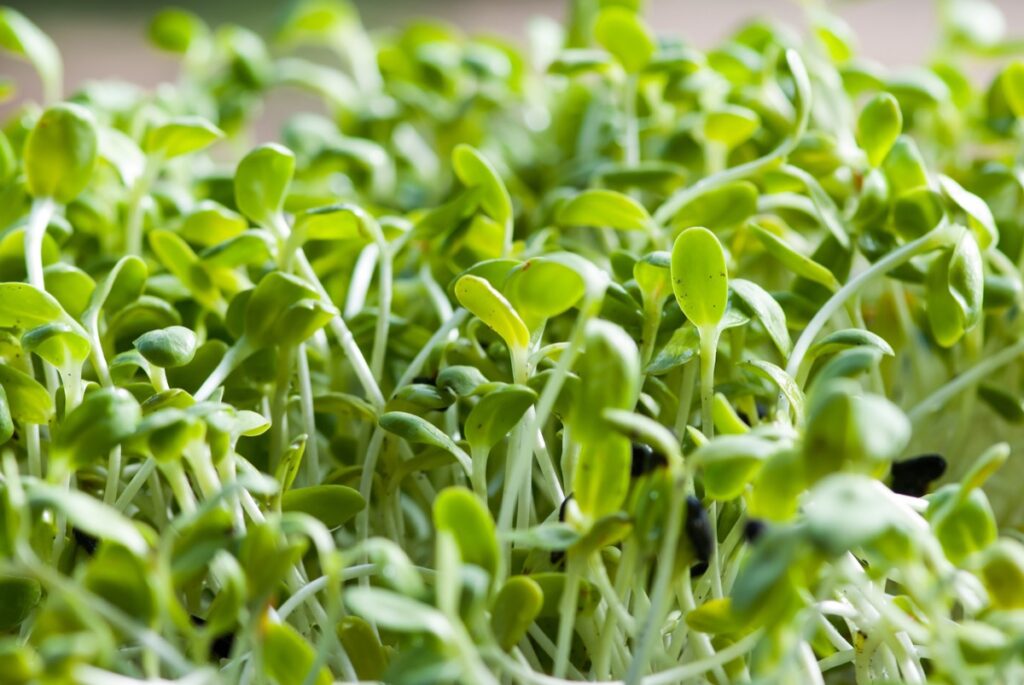
- Ammonium sulfate is a popular fertilizer for alfalfa. It contains 21% nitrogen and 24% sulfur. This fertilizer is applied at 20-40 pounds per acre.
- Urea is another common fertilizer used on alfalfa crops. It contains 46% nitrogen and is applied at a rate of 30-60 pounds per acre.
- Super phosphate is a phosphorus-based fertilizer that contains 20-30% P2O5. It is applied at a rate of 40-80 pounds per acre.
- Muriate of potash (potassium chloride) Muriate of potash is a potassium-based fertilizer that contains 60% K2O.
Alfalfa growth stages
Alfalfa is a perennial forage crop with four distinct growth stages: vegetative, stem elongation, flowering, and seed production.
- Vegetative stage is the initial growth stage where leaves and stems grow rapidly. The plant is mostly green with little to no flowers.
- Stem elongation stage: The alfalfa plant forms its main stem, and its leaves begin to lengthen. The plant will be green, with some flowers starting to form.
- Flowering stage: This is when the alfalfa plant produces its flowers. The plant will be mostly green with some white or purple flowers.
- Seed production stage: After the flowers have been pollinated, the alfalfa plant will start to produce seeds. The plant will be mostly green, with some brown or black seeds visible on the stems.
How tall does Alfalfa grow
Alfalfa is a fast-growing plant that can reach up to six feet in height. It is often used as forage for livestock, as it is rich in nutrients and proteins. When grown for this purpose, alfalfa is typically cut down to a few inches in height to encourage regrowth.
Conclusion
Hope the alfalfa growing guide will help you set up your alfalfa farm and produce good yields for feed for your livestock. Commercial cultivation of alfalfa crops will make you rich in a short time.
- Budget Friendly Sheep Shed Ideas: Cheap and Low-Cost Tips
- How Much Do Cattle Farmers Make: Revenue Streams in Cattle Farming
- Management Pests and Diseases in Your Cotton Field
- Sheep Farming Business Plan for Beginners
- Aquaponic Farming at Home: A Step-By-Step Guide
- Profitable Village Farming Business Ideas in 2024
- High-Yield Aquaculture: Fast-Growing Fish for Farming
- Effective Fish Pond Construction Techniques for Beginners
- Irrigation and Water Management in Pineapple Farming
- Blossom to Harvest: Mastering Flowering and Pollination in Papaya Farming
- Pig Fattening Essentials: From Selection to Sale for Beginners
- Raising Wagyu Cattle: A Complete Guide for Premium Beef Production
- Soil Types and Their Water Holding Capacity
- Optimizing Irrigation Schedules for Coconut Groves for Enhanced Yield
- Espresso Your Garden: Coffee Grounds for Healthier Acid-Loving Plants
- The Best Soil Mix for Snake Plants: How to Mix Your Own Snake Plant Soil
- Green Thumb Success: Expert Tips for Cultivating Greenhouse Beans All Year Round
- Bloom All Year Round: The Ultimate Guide to Indoor Hyacinth Care
- Eco-Friendly Gardening: How to Make Liquid Fertilizer from Kitchen Waste
- Ultimate Guide to Grow Anise in Pots: Explore Seed Propagation to Harvesting
- Guide to Raising Chester White Pigs: Discover Breed Facts to Growth Management
- Mastering the Elegance: The Ultimate Guide to Weeping Cherry Tree Care, Planting, and Maintenance
- Ultimate Guide to Planting Garlic in Grow Bags: Growing Strategies for Beginners
- How to Fix Spider Plant Leaf-Related Problems: Natural and Organic Remedies
- 10 Reasons Why Your Tulsi Plant is Shedding Leaves: Home Remedies and Solutions
- Optimizing Growth and Yield: The Advantages of Palm Bunch Ash Fertilizer
- Utilizing Neem Oil Extract as a Natural Pesticide for Hydrangea
- From Soil to Harvest: Various Ways in Which Farmers Can Use AI Tools
- Steps to Encourage and Induce Citrus Flowers: A Comprehensive Guide
- How to Fix Snake Plant Leaf-Related Issues: Natural and Organic Remedies
- Transform Your Garden into a Fragrant Oasis with Raat Ki Rani (Night Blooming Jasmine)
- Discover the Ideal Chicken Breeds for Philippine Farms
- How to Create a Poultry Egg Farm Business Plan for Profits
- Grow Lemon Cucumbers Like a Pro: Insider Techniques for Bountiful Yields
- Ultimate Guide to Caring for Your Pink Princess Philodendron: Tips for Thriving Variegation
- Areca Nut Profit Per Acre: Calculating Yield and Cost of Cultivation
